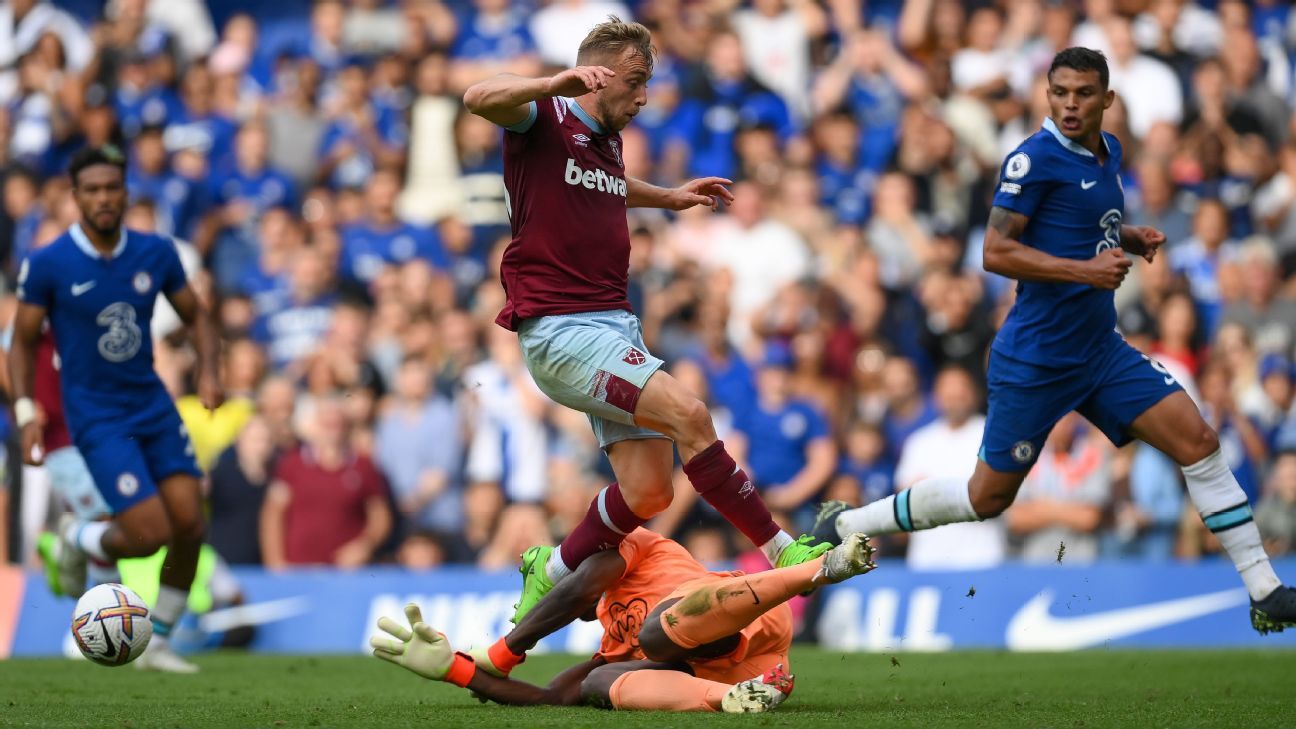Video Assistant Referee causes controversy every week in the Premier League, but how are decisions made, and are they correct?
After each weekend we take a look at the major incidents, to examine and explain the process both in terms of VAR protocol and the Laws of the Game.
– How VAR decisions affected every Prem club in 2022-23
– VAR’s wildest moments: Alisson’s two red cards in one game
– VAR in the Premier League: Ultimate guide
JUMP TO: Newcastle vs. Palace | Man United vs. Arsenal | Villa vs. Man City | Everton vs. Liverpool | Brentford vs. Leeds | Forest vs. Bournemouth | Brighton vs. Leicester | Spurs vs. Fulham
VAR overturn: Cornet goal disallowed for foul by Bowen on Mendy
What happened: Maxwel Cornet thought he had equalised for West Ham United in the 90th minute, but the VAR reviewed the attacking phase for a foul by Jarrod Bowen on goalkeeper Edouard Mendy.
VAR decision: Goal disallowed.
VAR review: One of two incidents this weekend which caused the Premier League to take an unprecedented step and ask PGMOL, the refereeing body, to explain the decisions outside of the usual postmatch assessment process (discussed in detail in the next section.)
The main issue in all leagues, not just in England, has always been the point at which the VAR should become involved. Was a challenge in the buildup to a goal of sufficient influence to disallow it? Often, VARs in the Premier League have been accused of being too reluctant to intervene, now the criticism has flipped — getting involved when the challenge seems so insignificant that it has no bearing on the goal.
For this Bowen incident the VAR, who was Jarred Gillett, decided that Bowen’s contact with Mendy was enough to cause an injury and left the Chelsea goalkeeper unable to react and attempt to save Cornet’s shot. While there is no argument there was contact with Mendy as Bowen jumped over the keeper, it was minimal and shouldn’t have caused Mendy to be injured.
Gillet does not have a game as VAR this weekend but will referee Leicester vs. Aston Villa.
We’ve seen a number of incidents this season when there has been contact between goalkeeper and attacker, and the VAR has decided to stay with the decision on the field. Leicester had a goal disallowed last weekend for a foul on Mendy, but that decision was taken by the referee. Then Aston Villa scored at Arsenal when Aaron Ramsdale clashed with Boubacar Kamara, and the goal stood as the VAR stayed with the referee’s decision. And it should have been the same here — there was nothing wrong with the decision of the match referee, Andy Madley.
Of course, the final decision rests with the match referee at the monitor, but the overturn process is effectively controlled by the VAR, and it’s highly unlikely the referee will disagree when presented with the evidence to support one particular outcome.
West Ham lost the game 2-1 and were denied what most likely would have been a point-earning goal.
VAR overturn: Mitchell own goal disallowed for foul by Willock on Guaita
What happened: Joe Willock collided with goalkeeper Vicente Guaita, with the ball going into the goal off Crystal Palace defender Tyrick Mitchell.
VAR decision: Goal disallowed.
VAR review: There are many similarities to the disallowed West Ham goal, being an alleged foul on the goalkeeper in the buildup to the goal. The question is how the VAR, Lee Mason, came to the decision that Guaita was fouled.
There is clear evidence that Willock was pushed into Guaita by Mitchell as he the Newcastle United forward was preparing to head the ball. But Mason decided that this was normal football contact, rather than any kind of illegal action by Mitchell. It’s a view that very few will get on board with, and like the West Ham goal PGMOL has accepted this was an error.
Mason is one of two full-time VARs in the Premier League; his sole responsibility is to be one of the best at judging when to get involved. He has not been assigned to a game this coming weekend. The other full-time VAR, Mike Dean, was at the centre of another controversy last month when he failed to recommend a red card for Cristian Romero when he pulled the hair of Chelsea defender Marc Cucurella. Dean later admitted his mistake in his column in the Daily Mail.
Where do the Premier League and PGMOL go from here? These are the only two incidents of a controversial weekend which the Premier League has questioned publicly, requesting a review as a priority. But will this achieve anything? Will anything improve? Contrary to the general narrative, the Premier League isn’t just standing back; it has wanted action for months and is taking steps to change the way PGMOL works and its structure.
A new five-person independent panel — featuring three former players and representatives of both the Premier League and PGMOL — was implemented at the start of this season to review all major refereeing incidents across a weekend. Its role is to assess each and supply feedback to clubs, which also forms part of the training and assessment process of referees and VARs. It’s hoped that this will help to improve the standard of officiating and the trust in the process between PGMOL and the clubs.
The process will remain private — unless of course the clubs themselves choose to divulge the outcome, which will most likely happen in cases where it suits. That leads to a situation where selective information leaks out, rather than it forming part of an open and transparent process for the whole game.
Let’s compare this to the situation in the German Bundesliga. Referees have in the past issued statements on specific occasions to explaining their decisions after games, but this season it’s happened far more frequently. While supporters may not always agree with the reasoning, there isn’t the void between the controversial incident — including the outcry from the media and fans — and the referee. On Friday, Daniel Siebert, one of Germany’s 2022 World Cup referees, chose not to give a penalty against Hoffenheim’s Ozan Kabak for handball vs. Borussia Dortmund. Siebert explained his reasons for not giving the penalty, and also accepted there would be an opposite view. And on Saturday evening, referee Felix Brych explained to broadcaster Sky Sport why he didn’t disallow a goal for Eintracht Frankfurt against RB Leipzig for offside.
Can the Premier League get to a situation whereby officials explain controversial decisions, in such cases as Newcastle and West Ham? In time it would be a positive addition, but it’s not likely to be something we see anytime soon. For now, the greatest level of transparency will come from Dean’s weekly column in the Daily Mail.
PGMOL is at the beginning of a major restructuring, with the headline being Howard Webb’s arrival as the new chief refereeing officer at the end of the year, as Mike Riley steps down from his role as general manager. That’s only part of the top-down rebuild within the organisation, pushed forward by the Premier League as part of its Elite Refereeing Development Plan to improve standards, and change the way referees move up through the ranks to reach the top flight.
But results of this restructure are not going to be instant, it will take some time for any changes to have any noticeable effect.
One thing is for certain: there is no prospect whatsoever that VAR will be scrapped in England. The Premier League would be the only major competition not to use technology, effectively admitting that richest league in the world cannot make it work. And while these two incidents were extremely poor, the Premier League doesn’t view the other VAR decisions across the weekend as being part of the problem.
VAR overturn: Martinelli goal disallowed for a foul by Odegaard on Eriksen
What happened: The game was goalless in the 12th minute when Bukayo Saka played Arsenal striker Gabriel Martinelli through to score. VAR Lee Mason initiated a review for a foul in the buildup by Martin Odegaard on Christian Eriksen.
VAR decision: Goal disallowed.
VAR review: On any normal weekend, this decision probably wouldn’t have caused the same furore as it did. But on the back of Saturday’s decisions, it was magnified — especially as the VAR was once again Mason.
There are a few facets to this. Let’s be clear that whoever was on the receiving end of this challenge in the buildup would expect the goal to be disallowed. But whoever supports the attacking team would not expect the VAR to become involved, feeling it was not a clear and obvious error by the referee.
This will come down to what referee Paul Tierney told the VAR he saw. If he believed Odegaard got a touch on the ball, and it’s clear this was not the case, it’s grounds for a review. That doesn’t mean it will definitely go to the monitor, because the VAR also has to subjectively believe a foul has taken place.
There is a disconnect between the Premier League’s desire for the game to be allowed to flow, not penalising minor infringements, and VAR’s remit to look at all fouls in the buildup. It also relies heavily on the individual subjective opinions of each VAR, because they simply won’t view each incident in the same way.
If a referee has been allowing such challenges to go through the game, the same should be happening with the VAR. It’s a difficult one to get right. Take the first week of the season when Liverpool claimed a foul in the buildup against Jordan Henderson before Aleksandar Mitrovic scored. This wasn’t as immediate to the goal as in the Odegaard example, and VAR Stuart Attwell chose not to intervene. Supporters will look at the two incidents and struggle to accept that there is a huge difference between the two.
No goal: Whistle blown before Coutinho scored
What happened: Coutinho thought he had scored to put Aston Villa 2-1 up in the 79th minute, but the whistle had already been blown by referee Simon Hooper.
VAR decision: No VAR intervention possible because the whistle had already blown to stop play.
VAR review: It’s worth mentioning that City goalkeeper Ederson only made a token effort to stop the shot from Coutinho after hearing the whistle, so we cannot consider this Villa being denied a certain goal. But how does this fit with VAR protocol?
With the delayed flag, the assistant is told they must always flag when they feel there has been an offside when the attacking move comes to an end. If they don’t flag, they haven’t identified an offside. But if they spotted what they assess to be offside, they must always flag.
It’s all about when an attacking move has ended. The unique factor in the Coutinho incident is he had a shot and scored. We see similar incidents across a weekend, but we would never notice them as play simply stops. In Brighton vs. Leicester on Sunday, Timothy Castagne came back from an offside position to the edge of the box and was preparing to shoot when the referee stopped the play because of the assistant’s flag.
There’s no question that Coutinho was onside; assistants will make mistakes. So let’s take a look at the VAR protocol to explain why the flag was raised.
When Ollie Watkins plays the ball (the direction of the pass is irrelevant for offside, a common misconception), Coutinho is in front of the penalty spot.
Coutinho then moves away from goal to collect the ball. If Coutinho had hit the shot when he first took possession, the flag would have stayed down and the goal would have counted.
The key part is Coutinho then moves out of the area and away from goal, and when the linesman raises his flag at this point the midfielder has three defensive players in front of him, and is about to be challenged. In the assistant’s view, there is no immediate prospect of Coutinho being able to have a shot on goal. It’s in line with protocol because Coutinho wasn’t moving towards goal.
The referee did have the option of holding his whistle despite the raising of the flag, but there are concerns about the impact on the defensive team in doing so — it’s why the delayed flag was brought in.
It was an unfortunate series of events for the assistant; first getting the offside decision wrong, and then raising the flag only for Coutinho to put the ball into the net. But the assistant does have a valid argument that when he raised the flag, the period for delaying the flag had expired.
Possible red card: Van Dijk challenge on Onana
What happened: In the 76th minute, Virgil van Dijk was booked for catching Amadou Onana on his shin with his studs. Referee Anthony Taylor issued a yellow card.
VAR decision: No red card.
VAR review: As discussed on a weekly basis in this column, the force and intensity of the challenge is far more important than the point of contact. Had Van Dijk been going into the challenge at pace, or out of control, there would have been a strong case for a red card.
As with Fabian Schar for Newcastle United at Wolves last weekend, a yellow card is not considered to be an unacceptable disciplinary outcome.
VAR overturn: Coady goal disallowed for offside
What happened: Conor Coady thought he had given Everton the lead in the 69th minute after tapping home from Neal Maupay‘s pass.
VAR decision: Goal disallowed for offside.
VAR review: There is no question that Coady was offside in front of the ball, and not by a small margin either. His foot is over the blue line which is drawn to the ball, let alone his upper body as he leans forward.
Any deflection off the toe of James Milner doesn’t reset the offside phase. As with Karim Benzema‘s disallowed goal for Real Madrid against Liverpool in the Champions League final, a blocking action from a defensive player is not considered to be a “deliberate play” of the ball. It was without doubt the correct decision to rule it out.
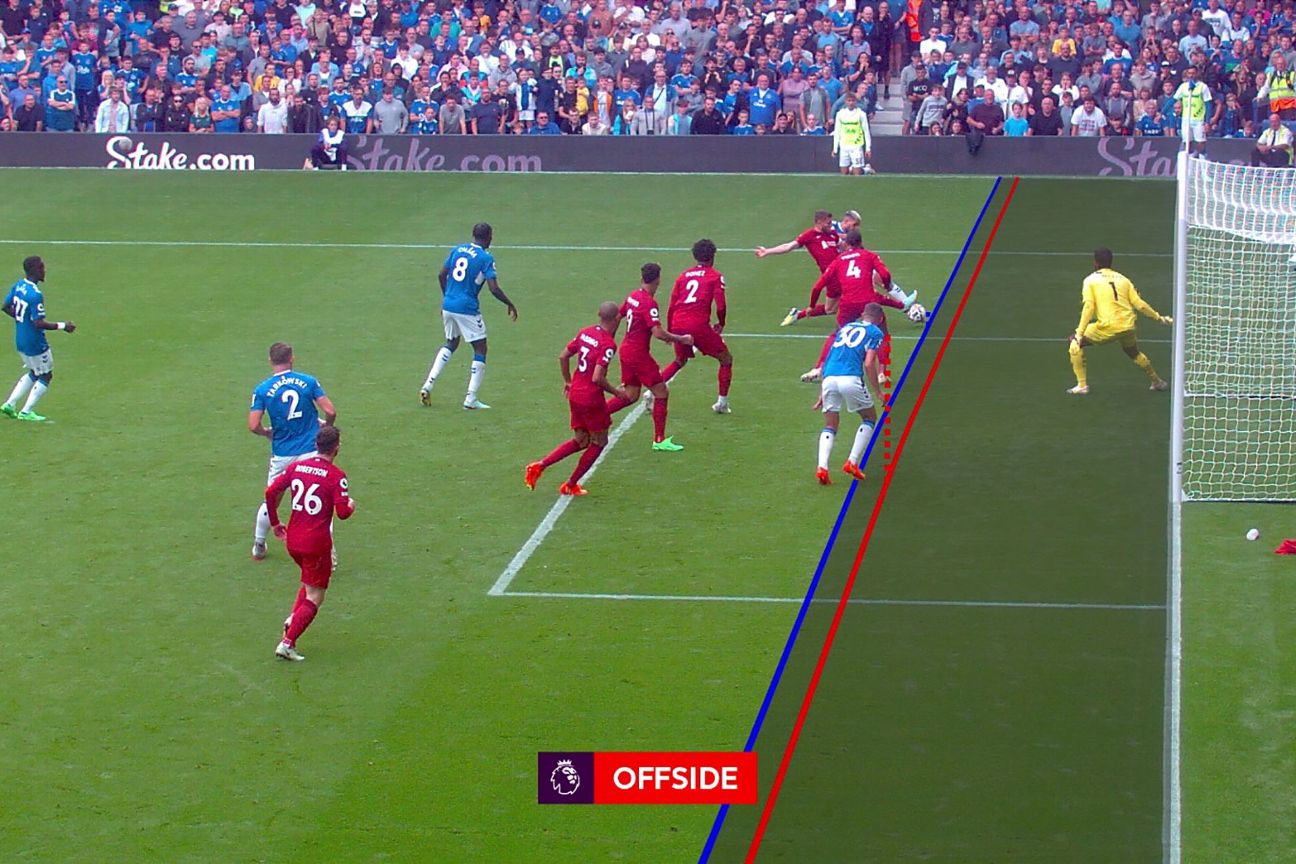
VAR overturn: Penalty awarded for a foul by Sinisterra on Toney
What happened: Ivan Toney moved in on goal when he was challenged by Luis Sinisterra. Referee Robert Jones indicated no foul and play should continue.
VAR decision: Penalty and a yellow card to Sinisterra.
VAR review: Referee Jones thought Sinisterra had got some of the ball when challenging Toney from behind with replays showing that wasn’t the case, resulting in the correct review for the penalty.
Possible penalty: Foul by Hickey on Summerville
What happened: With Brentford 3-1 up in the 62nd minute, Crysencio Summerville attempted to run into the box under a challenge from Aaron Hickey and went to ground inside the box. Referee Jones waved away the appeals for a penalty.
VAR decision: No penalty.
VAR review: This was clearly very frustrating for Leeds boss Jesse Marsch, who was sent off for his protests.
The was an initial shirt pull on Summerville by Hickey, which was on the blind side of the referee and could not be assessed by the VAR as it was outside the area.
But when Summerville reached the edge of the box there was an arm on the shoulder by Hickey, as well as contact between the players on the lower half of the body. There was a question as to the foul contact actually being inside the area, though this never came into the thinking of the VAR, David Coote. It was decided that Jones’ view that this was a coming together with minimal contact was correct.
Leeds fans will struggle to accept that, especially as they already had the earlier VAR decision go against them.
VAR overturn: Mbeumo goal allowed after incorrect offside
What happened: Bryan Mbeumo latched onto a long pass in the 80th minute before scoring to make it 4-2 to Brentford, but the flag went up for offside.
VAR decision: Goal allowed, no offside.
VAR review: The assistant thought the long pass had been flicked on by Toney, but the ball actually came off Robin Koch, meaning Mbeumo couldn’t be offside. The correct decision was to allow the goal.
VAR overturn rejected: Penalty for handball given against Kelly
What happened: In the 42nd minute, Lloyd Kelly turned his body into a shot from Neco Williams. Referee Michael Oliver awarded a penalty for handball.
VAR decision: Penalty should be rescinded, rejected at the monitor by the referee.
VAR review: For the first time since February 2021, and only the sixth time in more than three years of VAR in the Premier League, the referee chose to ignore the advice of the VAR (Graham Scott) and stick by his own decision. It’s something we desperately need to see happen more often to give more confidence to the system, proving that decisions remain in the hands of the referee and not by edict from the VAR room.
The Premier League’s aim for a high bar effectively means a VAR decision should not go to the monitor unless it’s a definite error, but as we saw from the incidents at Chelsea and Newcastle this weekend it simply isn’t the case that the VAR is immune from mistakes. It also assumes there could never be a subjective disagreement between the referee and the VAR. It’s almost inconceivable that not once last season did the referee get sent to the monitor but conclude he got the decision right.
Oliver gave the penalty because he believed Kelly turns his body to make it bigger with his arms after the shot by Williams. After viewing the replays he saw nothing to change that opinion, and hopefully we see more examples of this.
VAR overturn: Mac Allister goal ruled out for offside
What happened: Alexis Mac Allister scored a brilliant goal in the 47th minute, but there was a VAR check for offside in the buildup against Enock Mwepu.
VAR decision: Offside, goal disallowed.
VAR review: Much of the frustration from this comes from the time it took to reach the decision. This was partly caused by a struggle to find the best angle to plot the the last defender to create the offside line. There’s an argument that if the VAR cannot find this then the on-field decision should stand, as was the case in the 2020-21 season when West Brom’s had a goal Mbaye Diagne disallowed against Southampton when it looked like he was onside. The VAR couldn’t plot all players so made no decision.
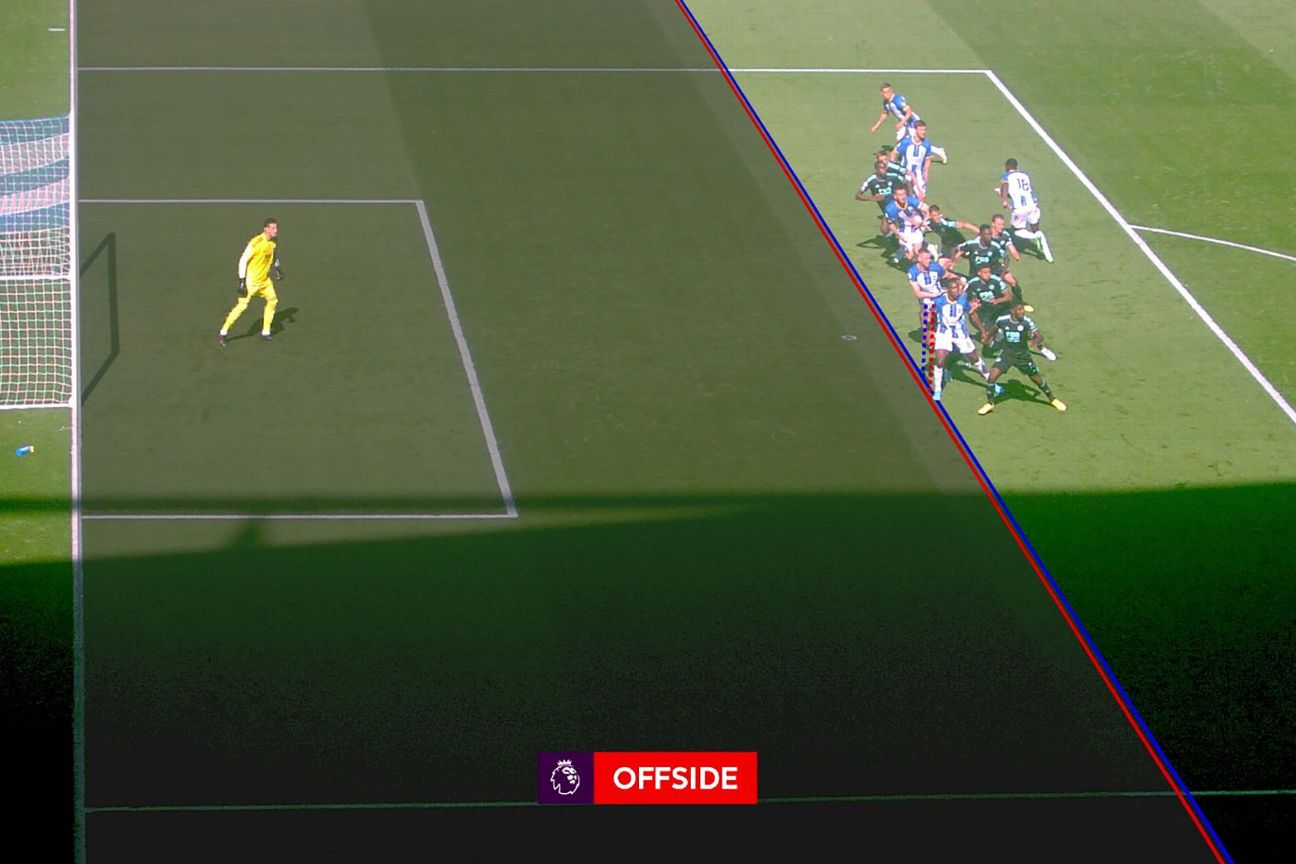
Would there have been so much anger about this if Mac Allister had scuffed the ball into the net rather than scoring a Goal of the Season contender? Probably not.
Once the offside position of Mwepu has been set, the question is whether the Brighton player became involved in the play — much along the same lines as Son Heung-Min‘s disallowed goal due to the influence of Harry Kane
Mwepu tries an overhead kick from an offside position which has to impact the defender behind him. As it was a subjective offside decision over the involvement of player who hasn’t touched the ball, the referee Tony Harrington has to make the final decision at the monitor.
Goal disallowed: Kane on the shot from Son
What happened: Son Heung-Min thought he had scored in the 10th minute, but the offside flag went up against Harry Kane.
VAR decision: No goal.
VAR review: Kane was in an offside position and made a clear movement to duck out of the way of the ball, correct decision to disallow the goal.
Kane was just behind the ball when scoring Tottenham’s second goal of the game, so couldn’t be offside.
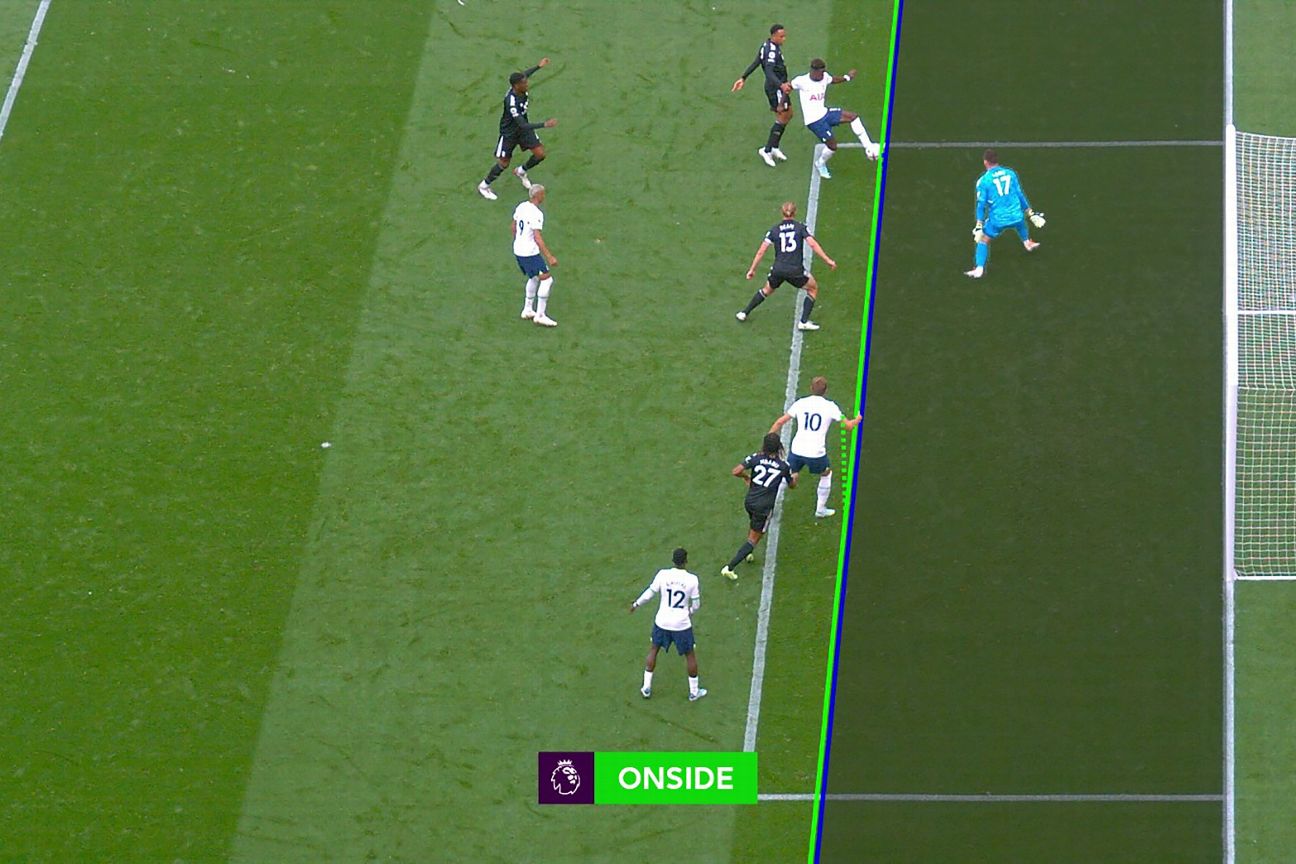
VAR overturn: Richarlison goal disallowed for offside against Sessegnon
What happened: Richarlison thought he had scored his first goal for Tottenham in the 90th minute but Ryan Sessegnon, who created the goal, was in an offside position.
VAR decision: Offside, goal disallowed.
VAR review: No question that Sessegnon was in an offside position when the ball was played. Richarlison was booked for removing his shirt in his goal celebration and even though the goal was ruled out any disciplinary action has to stand.
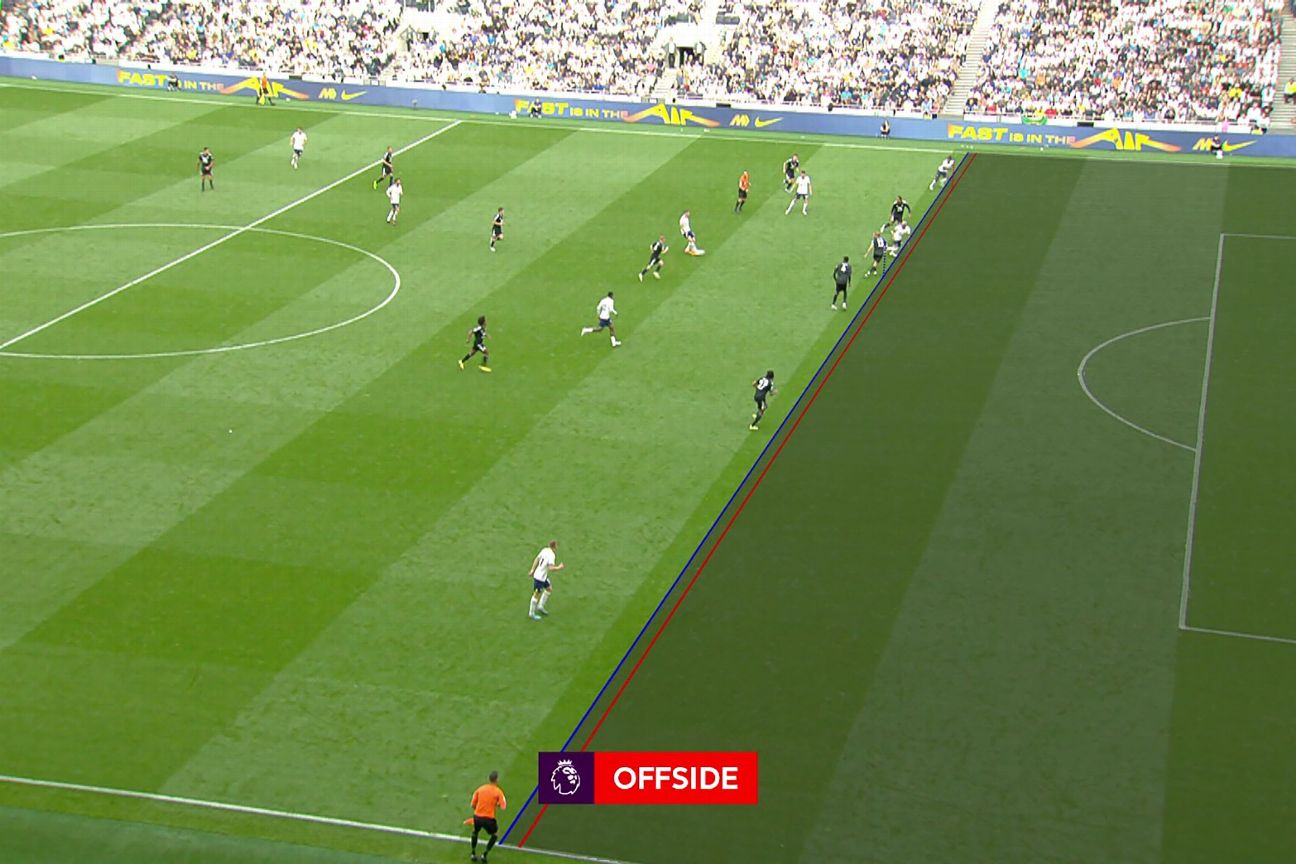
Information provided by the Premier League and PGMOL was used in this story.
